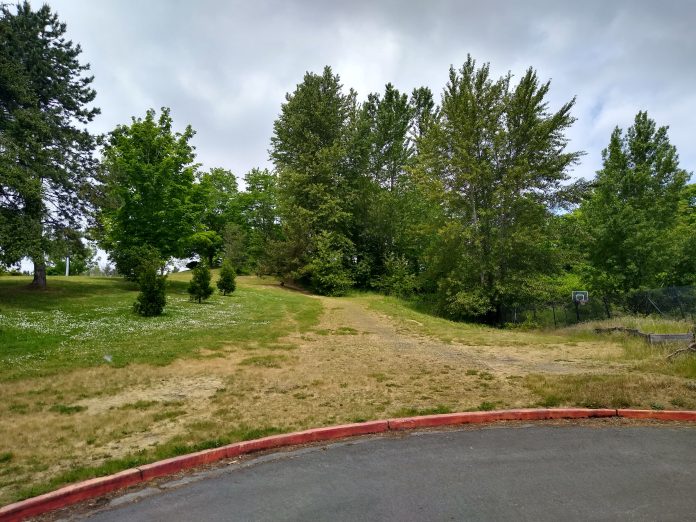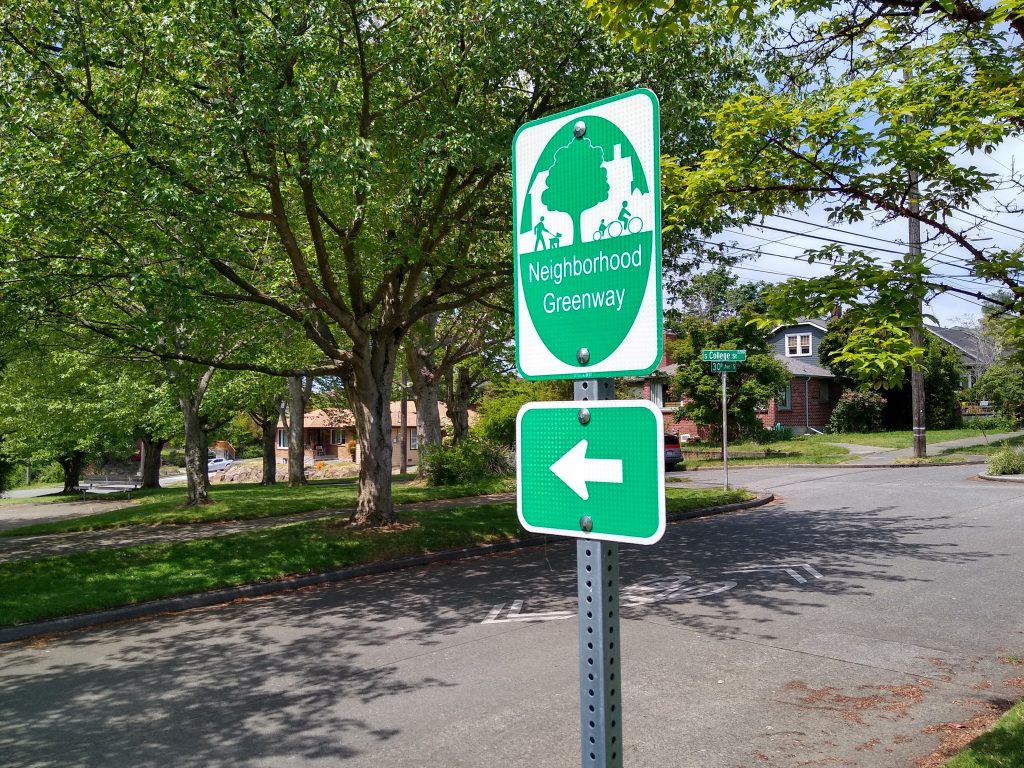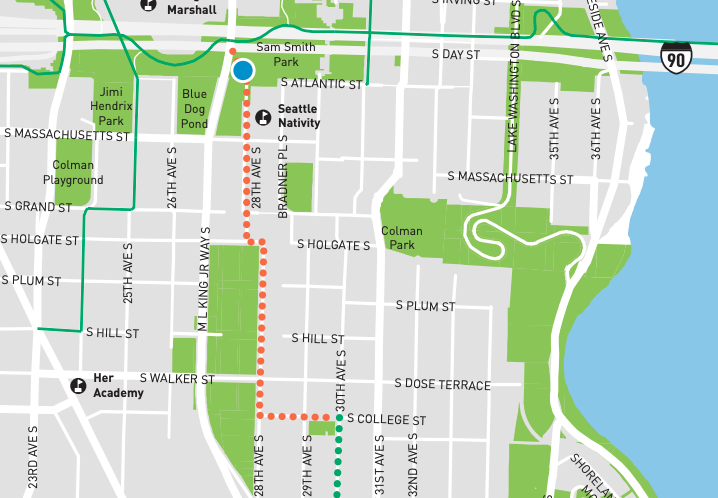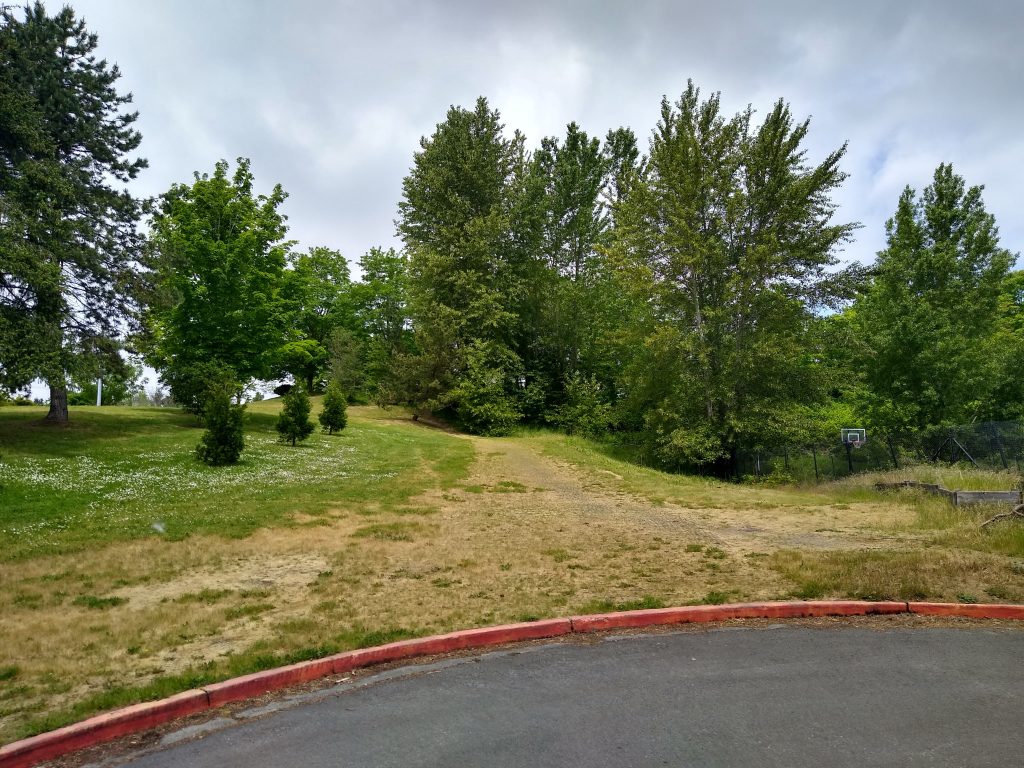
The Rainier Valley Neighborhood Greenway is the longest continuous greenway in Seattle, running over five miles from Rainier Beach to Mount Baker. Completed in 2018, the greenway takes a large of number of twists and turns to provide a signed, relatively calm walking and rolling route between and within Rainier Valley neighborhoods. But its utility to provide a safe crosstown biking route has always been hindered by its many twists and turns, and by another fact: it’s still incomplete. The greenway lacks a connection to the north and onto the Mountains-to-Sound Trail that connects Beacon Hill across I-90.

Today, if you follow the neighborhood greenway signage to 30th Ave S and S College St in Mount Baker, an arrow directs you down S College St, and after that you’re on your own. That’s because the planned final leg of the greenway, along 28th Ave S, was separated from the rest of the project after the Seattle Department of Transportation (SDOT) ran into a problem getting permission to construct a trail connection at the end of 28th. Without that trail, sending users down 28th doesn’t work. So for years, people have been left to figure out their own way to get to the trail.

The property in question is a part of Sam Smith Park, and is owned by the Washington State Department of Transportation (WSDOT). A set of emails obtained by The Urbanist reveal the long battle between SDOT and WSDOT to come to an agreement around use of the property. That battle has continued into 2021, when a lease agreement was on the verge of being signed between the state and the city early this year, but city staff were surprised to find that the proposed agreement would have committed SDOT to paying nearly $24,000 per year to WSDOT in perpetuity (tied to inflation) after paying to design and construct the trail connection itself.
Discussions with the state over completing this connection date to at least late 2016. City staff, including SDOT Greenways Project Manager Summer Jawson, met with WSDOT staff in both 2017 and 2018 regarding the proposed design for the trail connection, and the design was modified based on feedback from the state. Additional documents surrounding the project, including details of how it relates to Seattle’s comprehensive plan and Bicycle Master Plan, were provided to WSDOT to develop a trail agreement.

In September of 2018, WSDOT’s legal division determined that they wouldn’t be able to provide a no-cost trail lease because the trail doesn’t have anything to do with a state highway. “This segment of the [neighborhood greenway] is not adjacent to, severed by, or a part of any state highway. The trail does provide a separation of motor vehicle traffic and pedestrians from municipal streets and routes (increased safety), but not from a state highway. There is no reliever effect, joint use, highway purpose or other benefit to the state. We must pass this test before the state can issue a no consideration trail lease as a highway benefit,” Marty Stickford, Northwest Region Program Manager Supervisor at WSDOT told SDOT then.
Of course, the fact that WSDOT asserts no “reliever effect” from the creation of a connection to a five-mile neighborhood greenway in Seattle is narrow-minded and incorrect. People who would be using I-90 who live in or visit the Rainier Valley would be much more likely to use the greenway connection by bike instead of driving, if the connection actually existed.
After reaching what seemed like an impasse, SDOT’s Acting Chief-of-Staff at the time, Darby Watson, went to Barb Chamberlain, the director of WSDOT’s Active Transportation division, to see if there was another path available to making the connection happen. Chamberlain reiterated the decision made by the legal department: “Given the existing connection along the sidewalk and since no existing trail was severed by a state highway, this site doesn’t meet the statutory obligations that would enable a no-cost lease.” (The sidewalk is on MLK Jr Way S, one block away from 28th Ave S.)
After a site visit in 2019, Chamberlain wrote: “On our walk-through we identified a possible alternative for you to consider: A short connection to the sidewalk from the end of 28th would likely be something we could say yes to…If you were to approach this as a widening of the sidewalk that wouldn’t be a new trail.” A cost to this approach was alluded to in the same email. “SDOT is paid to maintain property on the lid. If that payment were reduced that could serve as consideration for the new facility. I don’t have a dollar figure; that would need to be worked out.”
In exchange for redesigning the trail to become a direct connection to a widened sidewalk along the east side of MLK Way, WSDOT would be able to grant an airspace lease. But emails after that point reveal it wasn’t clear to City staff that WSDOT would be adjusting the city’s compensation rate in that agreement due to the change. In 2019, WSDOT reimbursed the City of Seattle nearly $340,000 for maintenance work at Sam Smith Park. The proposed adjustment would have reduced the amount reimbursed yearly by $23,665. In 2021, when the the airspace lease was finally received by SDOT, Reiner Blanco, working on the project at SDOT, wrote to WSDOT: “We reviewed the proposed lease and were surprised to see the following, a $5,916 quarterly fee…Is there another type of agreement we should be reviewing / signing?”
The issue of whether the City of Seattle will pay for the privilege of being able to create a new connection across an underutilized property owned by WSDOT appears to be unresolved. SDOT Media and Public Affairs Lead Ethan Bergerson didn’t shed much additional light on where negotiations currently stand. “We still want to use this route to connect the Rainier Valley Greenway to the Mountains to Sound trail. The City is currently working with WSDOT to create a lease agreement which would allow us to build this portion of the route on state right-of-way,” he told me earlier this month. The city has been working with WSDOT to get such an agreement for nearly five years now.
This multiyear saga underscores the red tape and hurdles that come from having to negotiate with a state agency like WSDOT even on projects that clearly advance statewide goals around improving mobility and involve very few tradeoffs. The benefits of finally completing the Rainier Valley Greenway ran headlong into rigid and likely outdated state systems that are not set up to accommodate them. It’s unclear if a legislative fix or an administrative one would be the best final result here, not just for this specific connection but for others like it across the state. It is clear that something is broken.
Update: WSDOT spokesperson Bart Treece offered some further justification for the department’s actions in an email. He portrayed WSDOT as supportive of the greenway but constrained by state law.
“We have legal obligations that we must follow and are working with the city so we can come to an arrangement to achieve this,” Treece said. “Ideally, we look for no-cost solutions on something like this, which can be challenging at times. We are able to do this in one section of the greenway, but for another portion, the city must enter into what’s known as an ‘air space lease’ to use the property, which is required by state law.”
Treece wasn’t budging from the assertion that WSDOT’s hands were tied, meaning the City of Seattle would have to pay for the right to improve the WSDOT property and pay for the improvements as well.
“We completed a market analysis to develop the $24,000 lease fee,” Treece said. “We’ve been paying the city to maintain this property and others for some time, but since they want to change how this section is used, we will end up paying less and it becomes a credit. This is because there is a monetary value that must be associated and captured to ensure we are on firm legal footing.”
Ryan Packer has been writing for The Urbanist since 2015, and currently reports full-time as Contributing Editor. Their beats are transportation, land use, public space, traffic safety, and obscure community meetings. Packer has also reported for other regional outlets including BikePortland, Seattle Met, and PubliCola. They live in the Capitol Hill neighborhood of Seattle.

